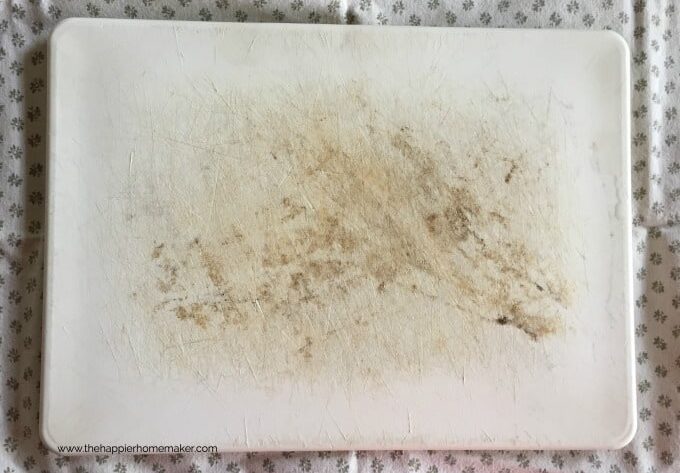In the heart of every kitchen, where culinary creations come to life, cutting boards stands as a silent witness to the daily dance of knives and ingredients. Yet, beneath its surface, a potential threat may be lurking – one that often goes unnoticed until it’s too late.
Old stained cutting boards, a common fixture in many households, may be more than just an eyesore; they can be a breeding ground for harmful bacteria, including the notorious E. coli, posing a serious risk to your immune system.
In this article, we delve into the unseen world of kitchen hygiene, exploring the dangers of neglecting your cutting boards and shedding light on the bacterial growth that can take hold. But fear not, for armed with the right knowledge and ingredients readily available in your kitchen, you can reclaim your cutting boards and ensure a safer, healthier cooking environment for you and your loved ones.
Join us as we uncover the science behind the stains and provide practical tips on how to effectively clean and disinfect your cutting boards, turning your culinary space into a bastion of hygiene.
Cutting Board Materials: Choosing Wisely for Health and Sustainability
Before we dive into the nitty-gritty of cleaning techniques, let’s take a moment to consider the materials our cutting boards are made of. The choice of material not only affects the longevity and appearance of the board but also plays a crucial role in determining its impact on our health and the environment.
1. Wooden Cutting Boards: Recommended
- Health Impact: Wooden cutting boards, often crafted from hardwoods like maple or bamboo, have been a staple in kitchens for centuries. They are less likely to dull your knives compared to harder surfaces, reducing the risk of slips and accidents.
- Environmental Impact: While wood is a renewable resource, it’s essential to choose sustainably sourced options to mitigate environmental impact. Look for certifications such as FSC (Forest Stewardship Council) when purchasing wooden cutting boards.
2. Plastic Cutting Boards: Not Recommended
- Health Impact: Plastic cutting boards are generally affordable and easy to clean. However, they can develop deep knife scars over time, creating crevices for bacteria to hide. Regular and thorough cleaning is crucial.
- Environmental Impact: Many plastic cutting boards are made from non-biodegradable materials, contributing to environmental concerns. Consider choosing cutting boards made from recycled or eco-friendly plastics to minimize your ecological footprint.
3. Bamboo Cutting Boards: Recommended
- Health Impact: Bamboo, a rapidly renewable resource, is increasingly popular for its durability and antibacterial properties. It’s an excellent alternative for those seeking a sustainable option with health benefits.
- Environmental Impact: Bamboo is known for its fast growth and minimal environmental impact. Choosing bamboo cutting boards supports sustainable practices and helps reduce deforestation.
4. Glass Cutting Boards: Neutral
- Health Impact: Glass cutting boards are non-porous, making them resistant to bacterial growth. However, they can be harsh on knives and may cause premature dulling.
- Environmental Impact: While glass is recyclable, the energy-intensive manufacturing process raises environmental concerns. Additionally, the weight and fragility of glass contribute to a higher carbon footprint during transportation.
As we consider the health and environmental implications of cutting board materials, it becomes clear that each option comes with its set of advantages and challenges. Regardless of your choice, regular maintenance and proper cleaning are essential to safeguard against bacterial contamination.
In the following sections, we’ll explore effective cleaning methods tailored to different cutting board materials, ensuring your culinary tools remain both safe and environmentally conscious. So, whether you’re a devoted chef or an occasional cook, let’s embark on a journey to reclaim the heart of your kitchen – one clean cutting board at a time.
Nurturing Your Wooden Cutting Board
Wooden cutting boards, cherished for their natural beauty, demand a little extra care to keep them pristine and bacteria-free. Here’s a brief guide for maintaining the longevity of your wooden culinary companion:
1. Regular Seasoning:
- Why: Prevent cracks and enhance moisture resistance.
- How: Apply food-grade mineral oil or beeswax regularly to keep the board hydrated.
2. Daily Cleaning Routine:
- Why: Remove food particles and prevent bacterial growth.
- How: Wash with hot, soapy water after each use, using a brush for thorough cleaning. Avoid prolonged soaking.
3. Lemon, Baking Soda, and Salt Scrub:
- Why: Natural antibacterial properties combat odors and sanitize.
- How: Scrub the board with coarse salt, baking soda and half a lemon, then rinse and air-dry.
4. Vinegar Disinfection:
- Why: Effective at killing bacteria on the surface.
- How: Apply white vinegar, let it sit, wipe away with a damp cloth.
5. Prevent Cross-Contamination:
- Why: Maintain a safe kitchen environment.
- How: Use separate boards for raw meats, vegetables, and other foods.
With these quick tips, your wooden cutting board will not only retain its aesthetic appeal but also provide a safe and clean surface for your culinary adventures.
Plastic Cutting Boards
Maintaining plastic cutting boards for a hygienic kitchen requires diligence and occasional replacement. Here’s a quick guide:
1. Immediate Cleaning:
- How: Wash with hot, soapy water immediately after use, using a brush for thorough cleaning.
2. Bleach Disinfection:
- How: Soak in a bleach solution (one tablespoon per gallon of water) for a few minutes. Rinse and air-dry.
3. Vinegar Soak for Odor Removal:
- How: Soak in a mixture of equal parts water and white vinegar for a few hours. Rinse and air-dry.
4. Regular Inspection:
- Why: Check for deep cuts, scratches, or discoloration regularly.
5. Knowing When to Replace:
- Signs: Deep cuts, stubborn odors, and discoloration.
- Why: Beyond a certain point, replacement is essential for food safety.
6. Eco-Friendly Alternatives:
- How: Opt for cutting boards made from recycled or eco-friendly plastics such as bamboo and wood.
Recognizing the End
Knowing when to say goodbye to a plastic cutting board is vital. Signs include deep cuts, stubborn odors, and severe discoloration. Choose eco-friendly alternatives for a sustainable kitchen without compromising hygiene.
Bamboo Cutting Boards
1. Oil Treatment:
- How: Apply food-grade mineral or bamboo oil regularly to prevent cracks.
2. Gentle Cleaning:
- How: Wash with mild soap and lukewarm water. Dry immediately to protect natural fibers.
3. Lemon-Salt Scrub:
- How: Scrub with a mixture of coarse salt and lemon. Rinse and air-dry.
4. Vinegar Disinfection:
- How: Wipe with a water-vinegar mix for a safe disinfection. Air-dry.
5. Baking Soda for Stains:
- How: Make a paste with baking soda and water for tough stains. Scrub and rinse.
6. Routine Inspection:
- How: Check for deep cuts or splinters regularly. Sand lightly if needed.
7. Knowing When to Replace:
- Signs: Excessive splinters, deep cuts, overly dry and brittle surface.
- Why: Replacement is essential for hygiene and safety.
Bamboo cutting boards, with proper care and timely replacement, offer both sustainability and a safe kitchen environment.
Conclusion: Hygiene and Sustainability
In the heart of every kitchen, where the alchemy of flavors unfolds, the choice of cutting board material becomes a silent but impactful decision. As we’ve explored the realms of wood, plastic, and bamboo, each material brings its own character to the culinary stage.
Wooden cutting boards, with their timeless charm, demand a nurturing touch to preserve both aesthetics and hygiene. Regular seasoning, immediate cleaning, and the use of natural deodorizers create a harmonious balance between tradition and modernity.
Plastic cutting boards, convenient and budget-friendly, require vigilant care to fend off bacterial intruders. Regular cleaning, disinfection with bleach or vinegar, will keep the bacteria at bay, but still not the most eco-friendly or health conscious choice.
Bamboo cutting boards, the eco-warriors of the culinary world, flourish with minimal care. Oil treatments, gentle cleaning rituals, and a watchful eye for wear and tear contribute to a sustainable kitchen, where renewable resources and hygiene coalesce.
In the symphony of culinary creation, the cutting board takes center stage, influencing the health of our meals and the sustainability of our choices. By embracing proper maintenance practices and knowing when to bid farewell, we not only ensure the longevity of these kitchen essentials but also contribute to a safer, cleaner, and more sustainable culinary journey.
So, as you embark on your next culinary adventure, armed with the knowledge of cutting board care, let your kitchen be a sanctuary where hygiene meets sustainability – a space where every chop and slice is a step towards a healthier, greener tomorrow.





